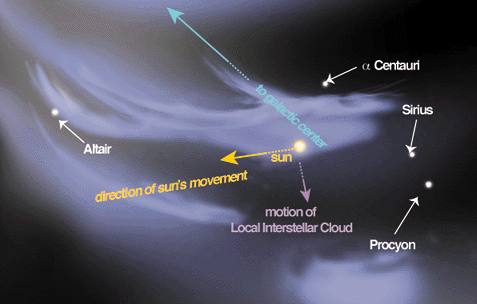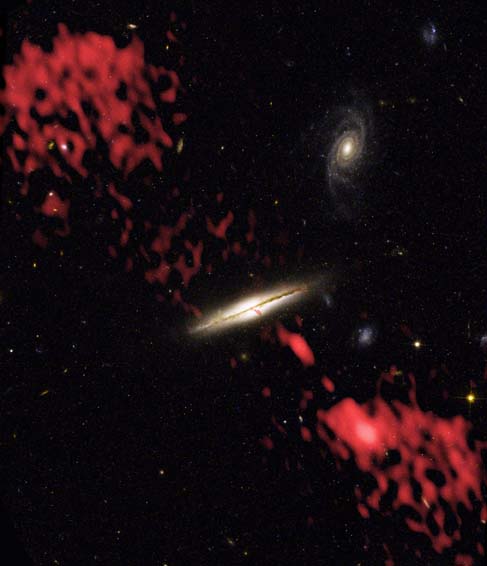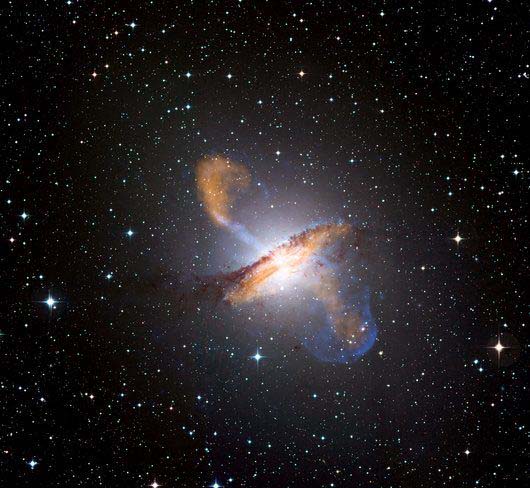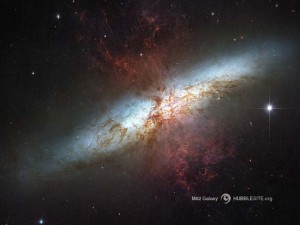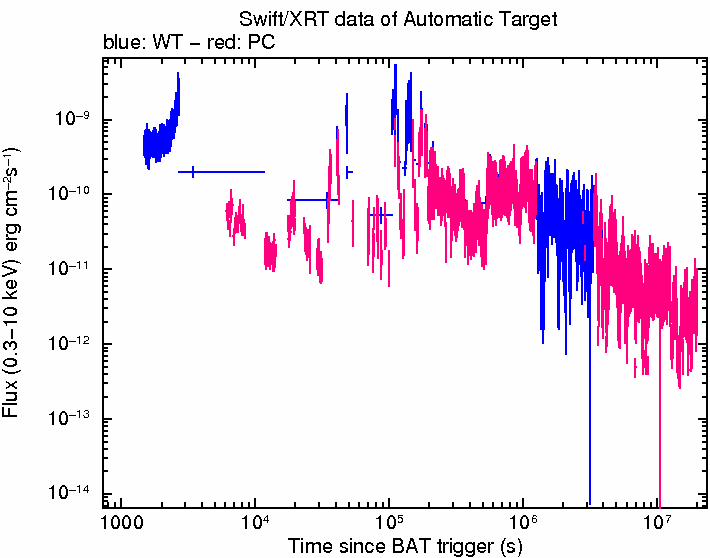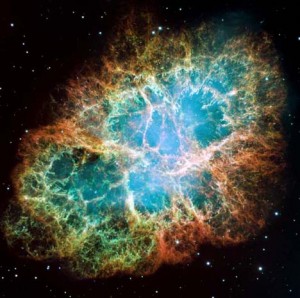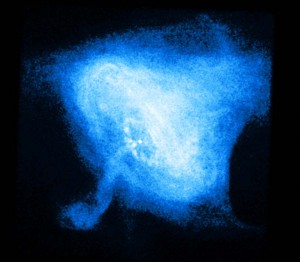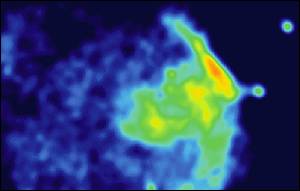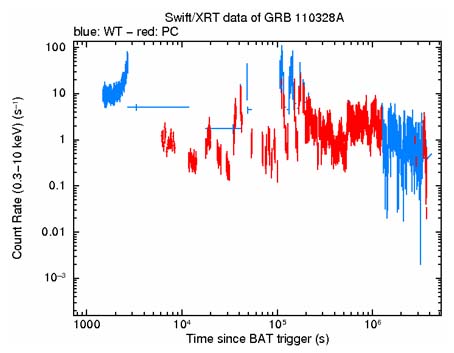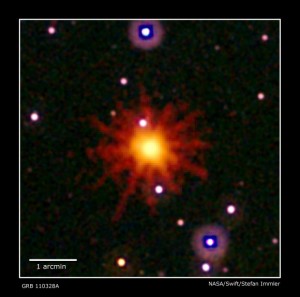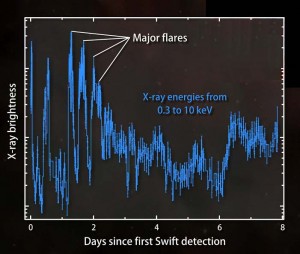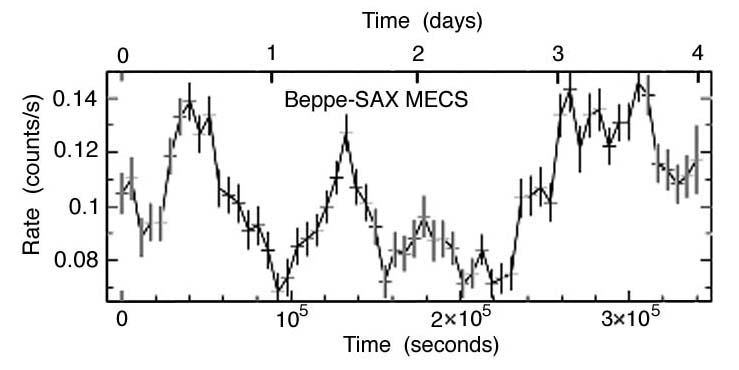Illustration courtesy of Linda Huff (American Scientist), Priscilla Frisch (U. Chicago)
Though we may have already been inside what is known as the Local Interstellar Cloud for tens or hundreds of thousands of years, scientists have been discussing regional areas, aka “cloudlets”, of variable density that we may have entered into as recently as the 1990’s. For example, see this NASA story from Feb. 2002 or this NASA story from Jan 2003:
“Some of those cloudlets might be hundreds of times denser than the local fluff,” says Priscilla Frisch, an astrophysicist at the University of Chicago who studies the local interstellar medium. “If we ran into one, it would compress the Sun’s magnetic field and allow more cosmic rays to penetrate the inner solar system, with unknown effects on climate and life.”
A collection of articles with brief summaries about this phenomenon may be found here: http://www.susanrennison.com/Joyfire_Interstellar_Cloud_Index.php
There seems to be a large overlap here with Dr. LaViolette’s theories about the galactic superwave and the chain-reaction effect it would have on the solar system, Sun, and Earth, with past events being recorded in the Earth’s polar ice core record. A few questions come to mind:
- How likely is it that the solar system’s movement through these variable density clouds will affect the Sun and Earth in a way similar to how a superwave has done in the past? Do you have any general thoughts on the significance of the Local Interstellar Cloud and its cloudlets with respect to its effects on our solar system/Sun/Earth/human bodies/minds? Is this a real danger to be concerned with?
- Would such an event inject extra-terrestrial dust sufficient to produce increased concentrationsof cosmic dust indicators similar to those you found in ice age polar ice core samples?
- Is it fair to say that possibly some of the evidence for elevated cosmic ray activity found in ice age ice core samples could be evidence for this kind of “compression” of the Sun’s heliosphere/magnetic field/etc. by these cloudlets?
————————————————————
I will try here to answer Matt’s questions.
a) Regarding the first question about the incursion of this approaching interstellar cloudlet. First we must ask how close is it and when will it actually be coming into our solar system? In this regard, if you check carefully the news announcements made by astronomer Priscilla Frisch, she does not say that such a cloudlet has actually been detected, only that there is a high likelihood that cloudlets may be embedded in the Local Interstellar Cloud (i.e., within the Local Fluff) which have gas densities hundreds of times higher than the Local Interstellar Cloud average. This Local Fluff is said to be 30 light years wide and travelling past us at 28 km per second. So at that rate we will be going through it for the next 300,000 years. If then such a cloudlet were as close as 1 to 2 light years away from us, at this rate it would take 10,000 to 20,000 years before it reached us. I would say that such an arrival date is a bit down the road and that there are more serious things to be concerned with before that time, such as the impending arrival of a galactic superwave which I expect a very great likelihood will occur in the next few centuries. Unfortunately, it is not possible to predict a superwave’s time of arrival through satellite observation since a superwave travels towards us at the speed of light. Hence when it has arrived, that is when we will see it.
In regard to getting a fix on any such cloudlet, as I understand it, our current satellite and spacecraft observations are not well enough refined to detect anything of this sort with any kind of certainty. The energized plasma ribbon discovered by IBEX which is positioned at the outer boundary of the heliopause is an entirely different phenomenon. In my opinion there is no relation of this to any so called impacting cloudlet. I believe the ribbon to be a stationary phenomenon associated with the heliopause shock region. The reason why it is so energetic is that our solar system was impacted by an intense volley of cosmic rays as recently as 11,000 to 16,000 years ago, with a very minor event possibly having impacted around 5300 years ago just prior to the emergence of Egyptian civilization.
Others do consider the possibility that there may be a connection between the ribbon and energization by the impacting interstellar wind. Dr. Frisch believes that this high energy band could be the first sign of any change brought about by an interstellar cloud entering the heliosphere. She says that the energetic neutral atoms in the IBEX Ribbon derive their energy from energetic ions in the solar wind and outermost regions of the heliosphere, and adjacent interstellar space. But we have no direct measurements of energetic ions beyond the heliopause. So all this is open to question.
However, suppose we assume for the moment that there is an impending threat from such a cloudlet incursion. Would the solar and climatic effects be like that of a superwave? Well we can do some calculations to find out. Given that the Local Fluff (LIC) has a density of ~0.1 hydrogen atoms/cm3. Above it was suggested that an approaching cloudlet inclusion could have a density hundreds of times greater than that in the Local Interstellar Cloud, hence a density of say around 20 to 50 hydrogen atoms per cubic centimeter. In a recent personal communication with me, Dr. Frisch related that the gas density in a very tiny dust cloud could even reach as high as 1000 atoms/cc. If we take this extreme example, we calculate a cloud density of around 1.5 X 10-21 grams/cm3. An interstellar cloud incursion of this sort, I believe, would have a significant climatic effect and a significant solar effect. But the most dangerous phase would likely last for several years, rather than for centuries or millennia as is often the case for the effects from a superwave.
I discussed a similar interstellar cloud incursion scenario in my 1983 PhD dissertation which is available in updated form on the Galactic Superwave CD at etheric.com. Pages 94 – 96 of this dissertation, mention the 1950 paper by Fred Hoyle and Raymond Littleton which examined this scenario of climate effects resulting from the incursion of an interstellar cloud having a density of 10-21 g/cm3 advancing toward the solar system at 1 km/s. They had proposed that energy released from the infall of this dust into the Sun would aggravate the Sun and increase its luminosity by up to 10% mostly in the ultraviolet.
The dense cloud that Frisch talks about as having an outside possibility of encounter with us would have had a gas density similar to the cloud that Hoyle and Littleton were considering but would be travelling almost 30 times faster. So, there would be a far smaller chance that any of it would be swallowed by the Sun and cause a luminosity increase of the sort they consider. Dr. Frisch related to me that astronomers today aren’t considering anymore the type of gas cloud encounter effect that Hoyle and Littleton discussed 60 years ago, that they are instead modeling the trajectory of today’s interstellar dust grains as they pass through the heliosphere. They find that the smallest of the grains don’t make it in at all because the Lorentz force excludes these high charge-to-mass grains. The largest grains are ‘gravitationally focused’ downwind of the Sun because of gravity and the relative Sun-cloud motion. There aren’t very many of these large grains because their number falls off with size as a power law.
So we might expect a similar situation for the passage of the dense interstellar cloud we were considering above. Because of its high velocity relative to the solar system (28 km/s), most of this gas would be gravitationally focused downwind of the Sun and hence would not become accreted by the Sun. Hence any luminosity change would be quite minimal. Hoyle’s cloud was moving very slow (1 km/s) and because of this the Sun would have accreted a very large quantity of its material. In the case of this much faster cloud passage, let us suppose that the Sun accreted only 5% as much gas causing a solar luminosity increase of just 0.5%. By comparison, solar luminosity normally varies by ±0.1% over the sunspot cycle. So this proposed local interstellar cloud incursion would cause solar luminosity to increase around 5 fold over the amount that normally occurs during the course of a typical solar cycle.
But the fractional increase in UV would be much greater. We know that currently the solar UV is maximum at solar max due to increased solar flare activity at the solar cycle peak with the variation amounting to about 10% – 20% of the total irradiance variation, hence this UV change amounts to about a 0.01% change in solar luminosity. Consequently, a 0.5% increase in UV of the sort expected from this hypothetical cloud encounter would cause an increase in UV 50 fold greater than occurs over the course of a solar cycle! This begins to approach the UV excesses seen in a T Tauri flare star and could pose a serious hazard.
The luminosity increase from this cloud encounter would be much smaller in magnitude than the climatic impact I had considered in my dissertation for a superwave dust incursion event. On page 96 of my dissertation I propose that the estimated cosmic dust influx that occurred during past ice age superwave encounters could have increased solar luminosity by 0.5% due to cosmic dust accretion by the Sun. This is in the range of luminosity increase we estimated above for the approaching interstellar cloudlet. However, in a superwave event I was noting that there would be a ten fold greater effect on the Earth’s radiation budget due to what I called the interplanetary hot house effect (light scattered from cosmic dust blown into the solar system by the superwave). I had estimated a 5% increase in radiation to the Earth just from this effect. Also I had indicated that there would have been a significant warming effect due to the reddening of the Sun’s spectrum caused by a dust cocoon that would have formed around the Sun, and also a cooling effect due to an increase in stratospheric dust concentration.
These cosmic dust effects, however, would be negligibly small in the case of an interstellar cloud incursion. According to Dr. Frisch, about 1% of the mass of the cloud would be in the form of cosmic dust. So in the case of the extremely dense cloud we discuss above, we are talking about a cosmic dust concentration of around 10-23 grams/cm3 invading the solar system. This would cause about a 5 % increase of the present interplanetary dust concentration, which is rather insignificant.
So how much of a climatic effect would a 0.5 % increase in solar luminosity have on climate? Scientists have searched for whether there may be a solar cycle climatic effect due to the ±0.1% variation in solar luminosity over the 11 year solar cycle. Generally they find there to be no impact on global climate. However, a recent study coming out of the Imperial College of London and Oxford has found that locally in Europe winter weather is affected, with winters being warmer at the time of a sunspot cycle peak (and solar cycle luminosity peak). So far we haven’t seen this to be the case with the current solar cycle since the European winter has been particularly cold this year, but we will see what happens next year. It is difficult to extrapolate for the case of this interstellar cloudlet, but definitely a 5 fold increase in solar luminosity from the solar cycle peak should make winters in Europe far warmer than we can remember. Maybe good from the standpoint of saving on heating bills. But I would expect there would also be some global effect with a luminosity increase this large. It is likely that it would worsen the past global warming trend and also reverse the current climatic cooling trend that some associate with the recent general reduction in the Sun’s flaring activity. This could accelerate polar melting with its associated sea level rise and could cause increased drought in the lower latitudes (e.g., Africa, southwestern U.S., etc.).
However, it is likely that this solar luminosity increase would not last for many years. Solar flare activity is tied to matter infall to the Sun. So we would expect that solar flare activity should dramatically increase and it might occur continuously, even during solar cycle minimum. We could likely expect a repeat of the 1859 Carrington Event, which if such occurred it could wipe out all satellite communication, down the electrical power grid on a global scale, and injure electrical appliances, plunging society back to the horse and buggy days. The U.S. National Research Council report warning of such a scenario is discussed here.
Also last year I published a paper demonstrating that the mass extinction of megafauna at the end of the ice age was likely due to extinction level solar proton events bombarding the Earth. This is discussed in the following press release. I don’t believe that the Sun would reach the level of activity that it had at the end of the ice age which is evident from NASA studies of lunar rocks. The reason is that the superwave incursion proposed to have been occurring at that time would likely have surrounded the Sun with a dust shroud that would have reflected light back onto the Sun and greatly participated in aggravating the Sun’s level of flaring activity. No such dense dust shroud would be present during the proposed cloudlet incursion. But I wouldn’t entirely rule out the possibility that the increase in solar activity associated with the proposed cloudlet incursion might produce a super solar flare of a size capable of producing a solar proton event of such large a magnitude.
If solar flare activity were to substantially increase, the increased solar cosmic ray bombardment would also cause increased destruction of the ozone layer. The polar ozone holes would likely expand to lower latitudes. A reduction in ozone protection coupled with a 50 fold increase in solar UV output would be disastrous. People would have to put sun block on any time they go out and would have to carry an umbrella with them to shield the Sun. Even if humans took precautions, when they ventured out into the Sun, would animals also take precautions and come out only at night? What about livestock? A large increase in the UV level could have a substantial impact on the food supply. There would be some negative effect on plant life, but would not nearly be as significant a hazard as it would be for animal life.
The only good thing about the elevation of solar activity is that this would increase the force of the solar wind and expand the heliopause outward, thereby helping to force this cloudlet away so that it travels around the heliopause rather than through it. So the effects of the cloudlet incursion would likely diminish after a few years as the Sun’s activity picked up. Thereafter, some lower long-term equilibrium level would likely be reached between the Sun’s level of flare activity and the rate of cloudlet gas influx. Currently, due to the lower than normal solar activity, the heliopause sheath is pushed in closer to the Sun. So the solar system is currently more vulnerable to a cloudlet incursion.
b) Regarding your second question, to compare this prospective increase in interstellar dust influx with the increases that occurred during the ice age (estimated from my analysis of Greenland polar ice), we would have to first know what is the cosmic dust concentration in this cloudlet. Above we estimated that this cloud would have a cosmic dust density of around 10-23 grams/cm3 which is 5% of the current interplanetary dust density. So incursion of the cloudlet dust would not come anywhere close to the scenarios I describe for a superwave arrival which would create dust concentrations over 1,000 times greater than what would be supplied by this cloudlet.
c) Regarding your third question, whether the evidence for elevated cosmic ray intensities recorded in the ice age portion of the polar ice record could have been due to past cloudlets compressing inward the heliopause, I don’t think that these could be attributed to cloudlet encounters. I still think that galactic superwaves are the best explanation for these recurring beryllium-10 peaks found in the ice record. It is a point of debate whether a compressed heliopause sheath is due to the impact of a cloudlet or simply to a reduction of outward solar wind pressure. I think that it is mostly dependent on the latter. Keep in mind that the heliopause is always impacted by the interstellar wind, whether a cloudlet is present or not, and its position on this upwind side is largely determined by a balance between the inward interstellar wind pressure and outward solar wind pressure. The presence of an interstellar cloudlet could increase the inward pressure, but the other side of the equation is the level of solar activity.
I understand that some astronomers are presently alarmed to find that the outer boundary of the heliopause is as close as 1000 AU with the inner boundary at ~70 AU. The heliopause sheath would be far more compressed during a superwave arrival. As I pointed out in my dissertation, during a superwave event, similar to those that appear to have occurred during the last ice age, the inner boundary of the heliopause sheath could have become so greatly compressed that its upwind side would have been positioned between the orbits of Mars and Jupiter, hence around 3 AU. This would have allowed easier entry of vaporized cosmic dust.
d) Just to add a few more things in regard to the first question. A superwave event would pose a far greater climatic hazard to the Earth and humanity and far more prolonged compared to the hazard that this cloudlet encounter would pose. The presence of this interstellar cloudlet could only worsen the effects that a superwave would have on our solar system since it would provide a greater supply of gas that could become blown into the solar system by the superwave. Since the superwave would compress the heliopause to a far greater extent than would otherwise occur, this material would enter far more easily than it would in the absence of a superwave.
Some speculate whether military forces around the world have been planning for such an event and this is why they have been building vast underground facilities and fallout shelters. A few places that come to mind are the facilities beneath the Denver airport, and many others are rumored to have been outfitted in the U.S. I was personally told about an abandoned gold mine which has been outfitted with living space far below ground level with space being leased out to people with money. The Norwegian government has been building a vast network of underground shelter facilities, or arks, as well as many other governments. Project Camelot has an interesting page on this. Some industrialists may also be in the know. Richard Branson has built 90% of his Virgin Galactic New Mexico Spaceport underground. See this AP news article and this LA Times article. Many in the area had wondered why so much of his construction was being built underground considering that land in the area is comparably inexpensive. Could the CEO have been tipped off about the possible occurrence of a future catastrophic event?
So the question that arises is whether all of this may have been inspired from fears about this incoming interstellar cloudlet and kept secret so as not to cause financial panic. By as early as 1963, the U.S. military reportedly had deployed satellites around all the inner planets and a few of the more distant outer planets at a time when NASA had only just announced sending a spacecraft to Venus; see Secrets of Antigravity Propulsion, page 396. The military has always been several steps ahead of NASA in solar system surveillance. Have they known about this cloudlet coming and have they for a long time been making preparations? Could they have access to information that is presently unavailable to the astronomical community? Or could it be they are preparing for a superwave arrival rather than an interstellar cloudlet arrival? This is left to speculation.
Dr. Frisch has told me that our knowledge of the local interstellar environment is continuously increasing. She says that we are getting more and better data on the Local Fluff, including high spectral-resolution Hubble Space Telescope data and measurements of the interstellar magnetic field in the Local Fluff. She feels that if there is a tiny dense cloud within 30 lightyears, we might be able to figure out a way to identify it in the next several years. Of course, even if such a cloud were at our doorstep, say 140 astronomical units (AU) away, we would have plenty of time before it arrived. At the current 28 km/s velocity such a cloud would move about 5.7 AU per year. So we would have 25 years before it reached Earth’s orbit at 1 AU.
Finally, some who are outside of the astronomical community and presumably are not themselves scientists, believe that the Local Interstellar Cloud may be hiding a planet X or brown dwarf that is approaching the solar system. I find this totally implausible. For one thing the amount of dust between us and the far end of this local fluff is so insignificant that it would not obscure such bodies. Furthermore if such a body were present it would have to be detected with an infrared telescope since the intrinsic temperature of a brown dwarf or planet drifting through interstellar space that far from our Sun will be no more than 120° above absolute zero (i.e., minus 150° C). Such objects can only be detected at infrared wavelengths in the range of 2 to 50 microns and such wavelengths are not affected by dust. They go right through completely unattenuated. In addition, the amount of obscuration is very low even at visible wavelengths. If we were to suppose that this presumed planet were 1 light year away, the dust column density obscuring it would be only 10-8 g/cm2 which is 1000 times less than the amount of dust between us and the Galactic center.
Paul LaViolette March 2, 2012

